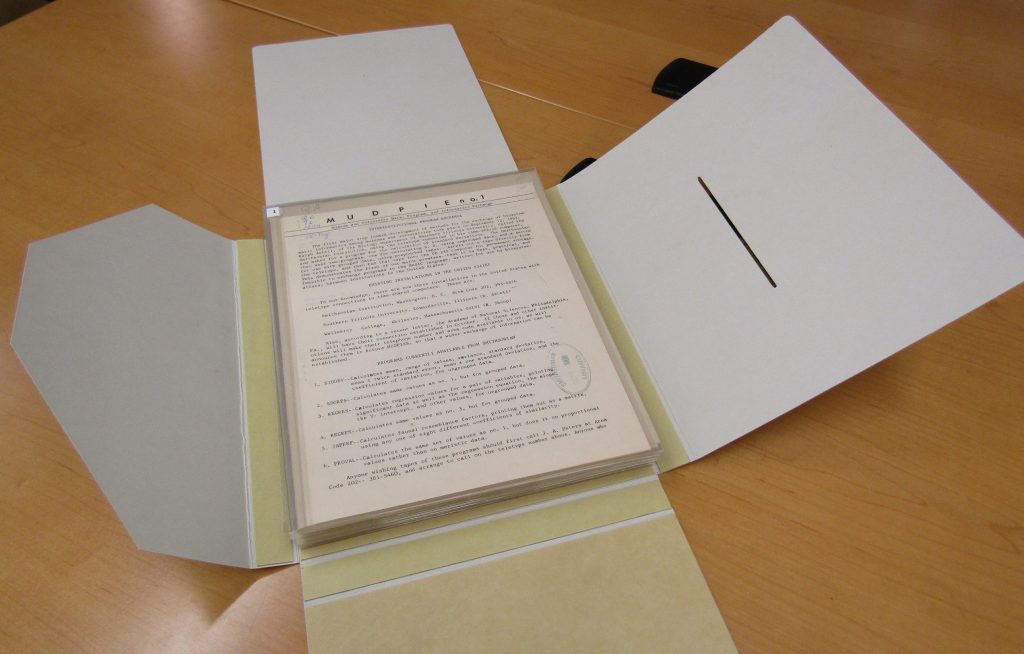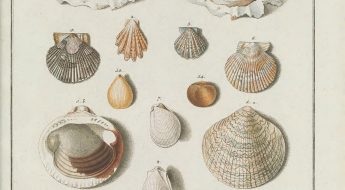MUDPIE — Online at BHL! Documenting the History of Computers in Museums
On September 12, 1967 Ralph Axtell, of the Biology Department of Southern Illinois University, called the Smithsonian Institution using the teletype connected to his time-shared computer and asked for a [computer] program for the calculation of standard deviations. The Smithsonian then sent him two computer programs. This demonstrated that, using data communications equipment and telephone lines, “it is fast, practical, and feasible to exchange programs in the BASIC language, written for use by biosystematists, between institutions in the United States.” A revolution had begun that would transform museums, research, systematics and science.
The following day, Dr. James A. Peters produced the inaugural issue of the MUDPIE (Museum and University Data Program and Information Exchange) Newsletter.
MUDPIE newsletter documents many early events in the adoption of computers and timesharing computing in museums and universities, and was founded and produced by Dr. Peters, the only editor in the newsletter’s publication history. Twenty-six issues of MUDPIE were produced and distributed over a five-year period, between September 1967 and September 1972. All issues are now digitally available at the Biodiversity Heritage Library thanks to the Smithsonian Libraries.

MUDPIE Newsletter masthead, number 1, September 13, 1967. Photo by David Bridge.
The length and contents of each MUDPIE issue varied depending on the amount of information available; it was published irregularly from two and eight issues per year; one to seven pages per issue. Peters’ name appeared infrequently; however some MUDPIE articles were signed with his initials “(JAP)”. The publication of the MUDPIE newsletter ceased with his untimely death.
Dr. James Arthur Peters (June 13, 1922 – December 18, 1972), biologist and herpetologist, held two positions in the National Museum of Natural History (NMNH), Division of Reptiles and Amphibians at the Smithsonian Institution, first as Associate Curator (1964–1967), and later Curator (1967–1972).

Dr. James Arthur Peters, herpetologist and MUDPIE editor, National Museum of Natural History, Smithsonian Institution. Smithsonian Archives, SIA2010-3050.
Dr. Peters clearly stated his aspirations in the first issue: “MUDPIE represents an attempt to keep everyone up to date on the development of time-shared computing in museums and universities engaged in systematic research. Several individuals receiving this first copy had written asking the same questions, and this is a quick way of answering them. There was a tremendous temptation to set it up so that it could be received only through the teletype and computer — but that proved to be a little too advanced for the present!”
This newsletter was a pioneering example of “electronic networking” between people. It foreshadowed the development of Usenet newsgroups, mailing lists, Listserv software, BITNET, and Internet Forums.
Two years later Dr. Peters wrote (p. 4) under the heading Participation in the Making of Mudpies: “There seems to be a genuine interest in the continued existence of this Newsletter, to judge from the number of people in the natural history museum business who have requested to be placed on the mailing list. We will continue to put it together and get it out at irregular intervals, but we have no objection at all to any of you who have something that you think might be of interest to others and send it in for inclusion to MUDPIE. We have had no indication of specialized programs written for use by systematists, for example, in the last few issues, but it is quite likely that such work is being done.”
Caroline A. Bull interviewed Dr. Peters on April 25, 1969, and provided an independent assessment (p. 47): “Museum and University Data, Program and Information Exchange, known by its acronym MUDPIE. There are six institutions which participate actively in the exchange. Each has computer access and cooperation ranges from the exchange of [paper] tapes to actual direct access to storage units. The direct access capability occurs only between the Smithsonian Museum of Natural History and the American Museum of Natural History in New York. Since these two [organizations] share the same central computer at C.E.I.R.[1] in Silver Spring, Maryland, each may tap into the others’ data bank and exchange messages and data directly. These two form the nucleus for a major network, which could involve other Institutions on the Northern Atlantic Seaboard. In addition to its computerized information exchange, MUDPIE circulates a monthly newsletter to some 100 individuals and institutions.”
The period 1967-1972 was well before the development of personal computers and major advances in data communications. The Teletype Model 33 ASR (Automatic Send and Receive) was the likely computer terminal of choice for time-sharing computing activities by MUDPIE members during this time-period. The Teletype was an electromechanical device which stored data and computer programs on punched paper tape in ASCII code. A Teletype Model 33 terminal that was used at the Smithsonian was connected to a telephone line using an acoustic modem, see illustration in Peters and Collette [2].
After Peters’ death George R. Zug [3]wrote: “James A. Peters died on 18 December 1972 of liver cancer. With his death, we have lost the most ardent supporter of a low cost museum and university time-sharing computer network. He had seen the concept of computer networks gain wider acceptance and had just participated in the first general working seminar on a National Science Computer Network in mid-November.
Jim established MUDPIE in 1967 in order to promote the use of time-sharing and the establishment of a computer network among the major American natural history museums. The scope of MUDPIE gradually broadened to encompass the use of time-sharing in all types of museums and for the analysis of all types of data, including systematic data.”
No copy of the MUDPIE mailing list is known to have survived. However, among Dr. Peters’ papers in the SI Archives[4] is a folder labeled “MUDPIE Letters”. This includes more than 120 items of correspondence largely related to MUDPIE memberships, but also includes some requests for reprints of publications listed in MUDPIE issues. In this folder there is a handwritten list of 24 names, labeled “MUDPIE #1”, which appears to be the initial newsletter distribution list. In April 1969, Bull and Shank, (p.47) reported that the membership was “100 individuals and institutions”. Requests to be added to the mailing list could have been received verbally in person, by telephone, etc. The “MUDPIE Letters” folder is certainly not a comprehensive list of names and organizations.
As word of MUDPIE newsletter spread and interest in computers grew, membership increased also. Bruce Collette[5], (p. 390) observed that, “The mailing list for MUDPIE was over 250, an indication of how much effect the interest and dedication of one man can accomplish.”
Outcome
This free interchange of data and computer programs probably seemed like a utopian dream for these early visionary of 1960’s, but has become the norm today with the adoption of open computer systems, open data standards, standardized software, high speed data communication networks, and of course, the Internet. The MUDPIE newsletter represents an important historical record of the early exploration of and developments in computer technology and its application in museums and systematic biology.
A special thank you is extended to the Smithsonian Libraries staff, particularly Martha Rosen of the National Museum of Natural History Library and its Smithsoniana Collection, who was a persistent advocate for preserving and improving access to the newsletter. And to the Preservation Services staff – Katie Wagner, Don Stankavage, and Michael Keeling – for their review, repair, and rehousing of the original MUDPIE newsletters.
Thanks also to Discovery Services staff – Erik Bergstrom and Dana Feil – for their review and re-cataloging, and for providing item-level description for the newsletters. And a final thank you to the Digital Programs and Initiatives staff – Jacqueline E. Chapman and Daniel Euphrat – for coordinating this process, digitizing the newsletters, and including them in the BHL corpus.
[1] CEIR or the Center for Enterprise Information Research was a commercial company which operated several computer data centers and provided, among other things, dial-up computer time-sharing service.
[2] Peters, James A. and Bruce B. Collette. 1968. The role of Time-share computing in museum research. Curator 11(1):65-75.
[3] George R. Zug, a colleague of Peters and Curator at the National Museum of Natural History.
[4] Smithsonian Institution Archives, Record Unit 7175, Peters, James Arthur, 1922-, James A. Peters Papers, and Records of the Division of Reptiles and Amphibians, box 37, folder 8.
[5] Collette, B. B., “James A. Peters”, Copeia, 1973 (2):388-390.






Leave a Comment